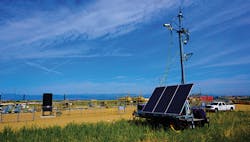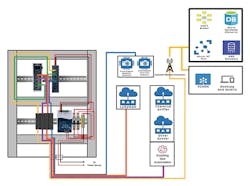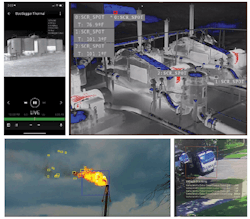Edge solution conquers connectivity challenges
Many industries—such as upstream oil and gas, water/wastewater, renewable energy and power distribution utilities—operate large numbers of remote sites. Modern sensors, automation systems and connectivity are vital for monitoring and controlling these widely dispersed assets. But many of these operations also demand onsite inspections by personnel, in some cases at every site, every day.
It's tempting to think that the proliferation of consumer-grade cameras could be leveraged to help these companies keep an eye on their assets, but the reality is there are many technical reasons why only industrial-grade solutions will work in the long run. Connectivity to remote locations is expensive, limited in bandwidth and often intermittent, so a degree of intelligence must be built into any such solution to process and store data.
Twin Eagle Solutions was founded more than 20 years ago as an industrial wireless consulting company, and it has extensive experience in that field, along with enterprise-networking and edge-computing expertise. Understanding the need for always-on solutions that can excel in the harshest conditions with limited bandwidth, it combines advanced edge and Industrial IoT (IIoT) technologies to push data and imaging information cost-effectively from the edge to the office, without straining the network infrastructure.
Long distance dilemmas
Automated production and operation sites in remote areas usually require attention beyond what can be provided by traditional instrumentation, programmable logic controllers (PLCs), human-machine interfaces (HMIs), and supervisory control and data acquisition (SCADA) systems. This often takes the form of in-person visits by operations, maintenance or engineering personnel. However, it's very expensive to deploy personnel to remote sites in terms of worker hours and travel expenses, and it increases risk of exposure to hazardous materials.
Even if a worker detects a problem, such as a leak, there may not be any indication of how long it's persisted. The leak could have started one minute before it was spotted or one minute after the last worker visit. End users everywhere are familiar with cameras used to monitor commercial and residential locations, so it seems natural to apply similar technology to industrial sites. Modern video and still cameras have the potential to take the place of some site visits, saving money and improving employee safety. If a picture is worth a 1,000 words, a video or enhanced video is worth much more.
Unfortunately, remote sites typically don’t have fast, inexpensive or reliable upstream networking connections, so bandwidth usage must be carefully controlled. This means that local (edge) pre-processing is needed to evaluate video signals in near-real-time, and condense the data transferred upstream. Some industrial cameras with a certain level of intelligence are available, but another common need is to coordinate video information with other inputs from field sensors or smart devices such as analyzers. This provides a complete monitoring solution.
One other point to consider is how the Internet and cloud computing are used for a given implementation. Solutions that rely heavily or exclusively on these technologies may not be suitable for remote industrial applications. From a business standpoint, even if a remote monitoring solution uses some aspect of cloud computing or connectivity, many companies want to own and manage their own data, rather than leasing it as a service.
A better vantage point
Recognizing these and other issues, the Twin Eagle Solutions team applied years of field-networking experience to develop its VisionAery solutions. They became practical, in part, because of the availability and performance of Emerson's edge controllers and industrial PCs (IPCs), both designed and rated for use in challenging environments.
An edge controller combines the functionality of a traditional deterministic PLC with general-purpose Linux-based computing, like a PC, in one consolidated and industrialized form factor. The deterministic side can interact with many types of field I/O signals, and can perform control and logic functions. The general-purpose side can communicate securely via a variety of communication protocols with intelligent field devices and higher-level systems, and it can interact with the deterministic side in a secure and carefully controlled manner using OPC UA.
An IPC is an even more capable general-purpose computing platform, and can run visualization, communication, analytical applications and more right at the edge. They can also interact with many PLCs or other field devices. Emerson offers both edge controllers and IPCs preloaded with industry-specific software to support edge and IIoT applications. Called PACEdge, the software enables scalable and open connectivity, visualization and analytics at the edge.
Edge computing is crucial for connectivity with intelligent field devices, and for performing the local edge computing necessary to consolidate edge data into useful information that can be sent offsite with minimal bandwidth required. Edge computing ensures that site/SCADA networks are not overloaded, and upstream communications costs (via cell, satellite or Internet) are minimized, providing users with the best view of their assets.
Figure 2: An Emerson edge controller connects with local instrumentation and intelligent cameras, preprocessing the data into a compact stream of information and video signals for efficient and secure transmission to authorized users worldwide.
Achieving clarity
When Twin Eagle set out to develop the VisionAery concept, the original target was to support remote oil and gas production sites. However, the designs are suitable for any type of remote location. The team developed a mobile trailer-mount version (Figure 1) and a skid-mounted, portable version that can be hoisted or moved by forklift. To date, VisionAery systems have been deployed at more than 100 field sites.
All data is processed onboard the VisionAery system using an Emerson edge controller and/or IPC depending on the scale and extent of the application (Figure 2). Because data is preprocessed, the resulting information stream is greatly reduced, making the solution viable for sites with limited connectivity.
The standard Remote Vision version of VisionAery supports remote sites by providing:
- Remote site inspection via video zones;
- Automated gauge readings;
- Alerting on abnormalities;
- Automated site surveys;
- Automated recording on triggered events (such as trucks entering the site);
- Simple true/false analytics; and
- Event counting.
Figure 3: The VisionAery platform uses Emerson edge technology to combine signals from intelligent video and thermal cameras with other site instrumentation, providing consolidated information such as (clockwise from top left) tank levels and leaks, equipment thermal profiles and operational parameters, vehicle tracking and flare status.
The more advanced Thermal Vision and Intelligent Vision versions provide added benefits (Figure 3), including:
- Detecting liquid levels and leaks;
- Monitoring flares (on, off or smoke);
- Supporting predictive maintenance for equipment;
- Monitoring to see if onsite personnel are wearing personal protective equipment (PPE);
- Identification of abnormalities;
- Tracking vehicle arrival/departure and operations, including license plate reading; and
- Integration with advanced analyzers such as methane leak detectors and audio analytics to listen for abnormal sounds.
Oil well site companies are subject to various operational environmental regulations, so it's vital to determine exactly when anomalous events like a smoking flare or leak started and how long they continued. Or, some sites must be periodically serviced by pump trucks, so detailed video information for vehicle tracking can ensure that service billing is correct.
All video and operational data is collected and stored locally, but local edge computing ensures that only essential results are transmitted to higher-level systems, so users obtain the best clarity regarding the situation in the field. Data can be converted at the edge into whatever protocol or coding language the end user needs, such as MQTT, JSON, Python scripts and more. Deployment is rapid, and Twin Eagle offers superior field support to adapt installations as needed for all types of field sites and enterprise computing host systems.
A new vision
In addition to the technical merits, an edge computing solution is affordable, requires no monthly subscription fees, is suitable for all types of edge environments and applications, and is expandable/scalable for the future. There are minimal annual renewal costs for the video management software, but most clients realize a return on investment within 12 months or less. Emerson edge controllers and IPCs enable Twin Eagle's VisionAery to excel today, with the ability to meet any future needs, such as adding LoRaWAN communications or connectivity to other advanced field devices.
Behind the byline
Kaylor Greenstreet is a board member and vice president of business development at Twin Eagle Solutions, and is is one of the creators of the VisionAery platform. He holds a business marketing degree from the University of Phoenix.
About the Author
Kaylor Greenstreet
Twin Eagle Solutions

Leaders relevant to this article:


